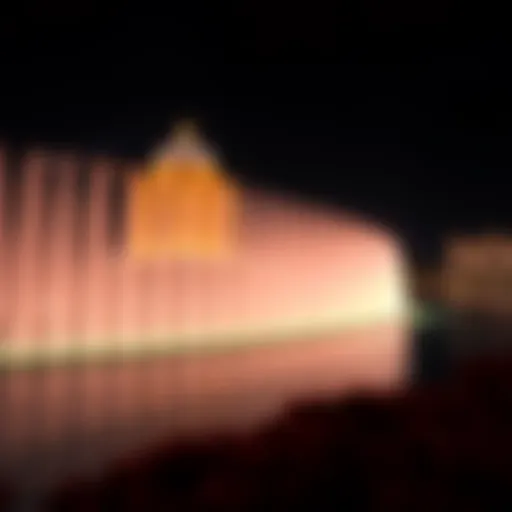Distance Between Sharjah and Dubai: Key Insights


Intro
The relationship between Sharjah and Dubai is often overlooked when discussing the broader dynamics of the United Arab Emirates. While both emirates are part of the same nation, the distance and subsequent travel dynamics between them play a crucial role in shaping various aspects such as real estate, commuting patterns, and lifestyle choices. For many expats and locals alike, the proximity can make or break housing decisions and job opportunities.
Understanding the distance between Sharjah and Dubai is not merely about kilometers. It touches on economic factors, transport options, and future urban development. Whether one is considering the bustling markets of Sharjah or the iconic skyline of Dubai, the comparative distance informs daily life decisions and investment potential. This article endeavors to explore these facets, paving a pathway for insights into real estate and personal lifestyle choices.
With approximately 30 kilometers separating these two vibrant areas, it may seem an easy commute, yet the nuances behind transport options, costs, and property values add layers of complexity. This analysis will serve as a springboard into a broader comprehension of how this distance impacts various stakeholders—from investors scouting for lucrative opportunities to expatriates weighing their living options.
Market Insights
Current Trends
In the ever-evolving real estate landscape of the UAE, Sharjah and Dubai stand out distinctly yet share notable trends. Many students and young professionals are flocking to Sharjah, drawn by more affordable living conditions, while still keeping Dubai within an arm's reach for employment and entertainment.
The demand for properties in Sharjah has surged as more individuals seek budget-friendly options. This has led to a ripple effect in Dubai, where the high demand and tighter housing market push some to consider Sharjah's lucrative alternatives. In contrast, luxury markets in Dubai continue to attract investments fueled by wealth, prominently from international investors.
Price Analysis
When it comes to property pricing, there's a stark contrast. A two-bedroom apartment in Dubai could fetch around AED 1,500,000 easily, while comparable properties in Sharjah might be priced closer to AED 800,000. This poignant difference opens up intriguing possibilities for buyers contemplating where to plant their roots.
- In Sharjah:
- In Dubai:
- Average rent for a three-bedroom apartment: AED 45,000 per annum.
- Capital growth potential is around 6% yearly, thanks to increasing demand.
- Average rent for a three-bedroom apartment: AED 110,000 per annum.
- Limited options tightening supply contribute to a price increase of about 10% annually in some areas.
"Understanding the price dynamics between Sharjah and Dubai equips investors with tools to navigate opportunities effectively."
Investors looking at property in either emirate should take a close look at not just the numbers, but the associated lifestyle benefits each location offers. Choosing to live in Sharjah while working in Dubai becomes more viable when considering the savings one can achieve on housing alone.
Geographic Context
Understanding the geographic context of Sharjah and Dubai is paramount to grasping the intricacies of real estate dynamics, travel considerations, and lifestyle choices within the United Arab Emirates. The proximity of these emirates creates unique implications for residents, investors, and commuters alike. This geographical closeness not only fosters economic interdependence but also enhances accessibility, making it crucial for anyone involved in the region to recognize how this affects personal and investment decisions.
Overview of the UAE
The United Arab Emirates, a federation of seven emirates, exemplifies rapid development and innovation while maintaining cultural richness. Among the emirates, Sharjah and Dubai are often viewed as two sides of the same coin, each offering vastly different yet complementary lifestyles. Sharjah, known for its cultural heritage and family-friendly atmosphere, contrasts sharply with the fast-paced, cosmopolitan environment of Dubai. This contrast in natures symbolizes the diverse fabric of the UAE itself.
Notably, Sharjah is recognized as the cultural capital of the UAE, housing several museums and art exhibitions, such as the Sharjah Art Museum and the Sharjah Heritage Area. In contrast, Dubai shines as a business hub, attracting global talent and showcasing architectural marvels like the Burj Khalifa and the Palm Jumeirah. The varied offerings of these emirates make them attractive both for those looking to settle down and for investors seeking growth opportunities.
Positioning of Sharjah and Dubai
Sharjah and Dubai sit adjacent to each other along the northern coast of the UAE, separated only by a few kilometers. Specifically, Dubai is positioned to the southwest of Sharjah, making it very convenient for travel and trade between the two. This overlapping boundary promotes a remarkable fluidity, allowing people to navigate between the two emirates with relative ease.
The road network connecting them is well-maintained and efficient, embodying the spirit of modern infrastructure in the UAE. The main thoroughfares include the Sheikh Zayed Road and Al Ittihad Road, both of which see a constant stream of commuters and services. The connection is more than just physical; it fosters economic relationships that enhance the job market, cultural exchanges, and investment opportunities across both emirates.
Distance Metrics
Understanding the distance between Sharjah and Dubai is more than just a number; it's a vital piece of information that shapes travel decisions, real estate investments, and lifestyle choices in these two emirates. Knowing how far apart these cities are can guide potential homeowners, investors, and travelers in making informed decisions. Moreover, it can impact commutes, give insight into regional connectivity, and affect the daily life of those who straddle the boundary between these two dynamic hubs.
The Distance Metrics segment of this article will meticulously break down the various ways one can measure the distance between the two cities, whether by road or air. It brings to light important aspects like average travel times, the efficiency of various routes, and the implications those distances could have on commuting habits and property values.


Measuring the Distance
Measuring the distance from Sharjah to Dubai is foundational for both existing residents and those contemplating a new life here. Various methodologies exist for measuring distance, each with its unique significance.
- Straight-Line Distance: This is often the simplest calculation, measuring the direct path between two points. While not necessarily useful for navigation, it provides a baseline understanding of how closely linked these cities are.
- Road Distance: This metric accounts for the actual driving route, including highways and intersections. It's this measurement that most affects daily commutes and travel choices.
- Air Distance: Though not typically relevant for land travel, understanding air distance can be important for business and personal travel, including short flights or drone deliveries in the future.
A comprehensive analysis of these distances will help clarify logistical considerations and accessibility for anyone looking to move or invest in the area.
Distance by Road
When discussing distance by road, the most common route from Sharjah to Dubai is along the Sheikh Zayed Road. The driving distance typically falls between 25 to 30 kilometers, depending on your specific starting point in Sharjah and your destination in Dubai.
The main routes include:
- Sheikh Zayed Road (E11): This is the primary arterial road that connects both cities. It's a well-maintained expressway offering a relatively quick journey when traffic is minimal.
- Emirates Road (E611): An alternative path that can sometimes ease congestion during peak hours.
Traveling along these routes generally takes about 30 to 40 minutes under normal conditions. However, be prepared for potential delays during rush hours, especially in the mornings and early evenings when people are commuting to and from work.
"The efficiency of the roads between Sharjah and Dubai plays a crucial role in daily life and investment decisions, making understanding the metrics even more important."
Distance by Air
While the majority of travel between Sharjah and Dubai occurs via road, air distance remains a useful perspective. The direct flight distance is approximately 20 kilometers, providing a fascinating contrast to the longer road distances.
The aviation aspect often appeals to businesses in logistics and emergency services, where time is of the essence. Furthermore, air travel connects these emirates to the broader world, with Sharjah International Airport and Dubai International Airport both being major hubs.
Travel Options
Exploring the myriad of travel options between Sharjah and Dubai is crucial, especially for those contemplating a move or commute between these two emirates. The methods of transit not only influence daily commuting patterns but also heavily affect lifestyle choices and real estate decisions. Whether you prefer the freedom of a personal vehicle or the cost-effectiveness of public transport, understanding your travel options is an essential step in navigating life in and between these vibrant locales.
Driving from Sharjah to Dubai
Driving between Sharjah and Dubai is often the most direct and flexible option. The distance typically spans around 30 kilometers, and depending on traffic conditions, it can take between 30 minutes to an hour to reach your destination. Many residents opt for their own vehicles and enjoy the convenience it brings.
Aside from the speed, having your own car allows for spontaneous trips, whether it’s heading to a mall, a beach, or any other attraction that both emirates offer. Conversely, driving isn’t without its drawbacks. The roads can become heavily congested, particularly during peak hours, leading to delays that can add a good chunk of time to your journey. Moreover, some might find the ongoing costs of fuel and parking to be burdensome.
Public Transport Alternatives
Exploring public transport is a viable and often economical alternative to driving. It opens up a world of options that cater to different needs and preferences.
Bus Services
Bus services connecting Sharjah and Dubai are quite comprehensive, operated mainly by the Sharjah Public Transport Authority and Dubai's Roads and Transport Authority. These buses are not only budget-friendly but also cover numerous routes, making it easier than ever to travel.
One key characteristic of these services is their frequency. Buses regularly run throughout the day, often every 30 minutes, helping commuters minimize waiting times. A major plus is that you can relax while someone else takes care of the driving, allowing for a moment to catch up on reading or simply enjoy the views. However, one limitation is that bus routes may not always land you exactly where you want to go, requiring additional transfers or a bit of extra walking.
Investing in a bus pass can also be economical for frequent travelers.
Metro Connectivity
The metro is another popular avenue for those navigating between Sharjah and Dubai. Although there currently isn't a direct metro link from Sharjah to Dubai, many residents find an efficient workaround. They can first take a bus to designated metro stations in Dubai and then use the metro to continue to their final destination.


A critical feature of the metro is its speed and efficiency. Besides reducing travel times substantially, it avoids road traffic entirely. The metro system is known for maintaining strict schedules, keeping riders on track. However, it’s worth noting that the additional transport time to first reach the metro stations can sometimes negate these benefits.
In summary, while both bus and metro services have their respective pros and cons, they certainly contribute to a seamless experience for those commuting between Sharjah and Dubai.
Taxi and Ride-Sharing Services
For those who prefer the comfort and privacy of a private ride without the hassle of driving, taxi and ride-sharing services like Careem or Uber are readily available. These services offer door-to-door convenience, allowing passengers to relax during their journey. However, while they provide immediate availability and comfort, it is essential to keep in mind that fares can add up over time, especially for daily commuters.
Overall, understanding the variety of travel options available between Sharjah and Dubai can greatly inform your choices, whether you’re an investor looking into properties or simply working in one emirate while living in the other.
Travel Time Considerations
When thinking about the commute between Sharjah and Dubai, it's not just about the distance; travel time can heavily influence daily routines, productivity, and personal satisfaction. How long it takes to make this journey is crucial for both residents and those contemplating a move.
Factors Affecting Travel Time
Travel time between Sharjah and Dubai can vary for numerous reasons. Some of the key elements that impact how long it takes include:
- Road Conditions: The quality of roads might be good, but accidents and construction can still cause delays.
- Traffic Volume: Rush hours in an urban environment like Dubai can turn a quick trip into a lengthy ordeal.
- Weather Conditions: Sandstorms and rain, though rare, can disrupt travel considerably.
- Mode of Transport: Different travel methods have varying speeds, like buses versus private cars. Factors like stops along the way and the time taken to wait for public transport can also add to the mix.
Understanding these factors plays a crucial role in planning your day and making informed decisions.
Typical Commute Duration
On a normal day, here’s a rough breakdown of typical travel times between Sharjah and Dubai:
- Car: Driving directly can take between 30 minutes to 1 hour, depending on traffic. When the roads are clear, this can be a pleasant ride. But during peak hours, it often takes longer.
- Bus: Public buses typically take about 1 hour to 1.5 hours. While economical, it requires patience because buses tend to stop frequently.
- Taxi/Ride Share: Using a taxi or ride-sharing service can be similar to driving, yet it might differ slightly based on the taxi's route or traffic conditions.
For someone needing to travel between these two bustling cities, factoring in this time is essential to avoid lateness.
Peak Hours vs. Off-Peak Travel
Timing is everything. Knowing when to travel can save precious minutes, if not hours. Here’s how peak hours differ from off-peak:
- Peak Hours: Typically from 7:00 AM to 9:00 AM and 5:00 PM to 7:00 PM. During these times, the roads become congested. Both cities experience a flux of people moving for work and other activities, making the journey feel much longer.
- Off-Peak Hours: Traveling outside these hours, for instance, mid-morning or after 8:00 PM, can yield a quicker and more pleasant journey. Less congestion means more time remains for other activities.
Planning your travels around peak hours can greatly improve efficiency, leading not only to faster commutes but also less frustration.
To sum it up, understanding travel time considerations is not merely a statistical analysis. It's about optimizing daily life, ensuring a delicate balance between work and personal time, especially in such a dynamic region.
Real Estate Implications
The connection between Sharjah and Dubai plays a crucial role in shaping real estate dynamics in the region. With the close proximity of these two emirates, potential homeowners and investors often weigh their options carefully, considering factors like travel times, lifestyle benefits, and property market stability. As both cities are woven into the UAE's economic fabric, understanding how real estate operates in each can provide insights into the lifestyle and investment strategies available.
Living in Sharjah, Working in Dubai
Living in Sharjah while maintaining a job in Dubai has become a more common scenario, particularly for expatriates and young professionals. This arrangement offers several advantages. First, property prices in Sharjah are generally more affordable compared to Dubai, making it an attractive choice for those looking to buy or rent without breaking the bank. Sharjah's family-oriented neighborhoods foster a sense of community that is appealing to many.
Residents enjoy the ability to secure a spacious apartment or even a villa at a fraction of the cost found in Dubai. Additionally, Sharjah is renowned for its cultural heritage and education, with several universities and museums that enrich the living experience. But taking up residence here doesn't come without its challenges—commuting can be a double-edged sword. In peak hours, travel times can stretch, complicating the daily routine for those working in Dubai. However, many choose to take this on given the benefits that residing in Sharjah provides.
Investment Opportunities in Both Emirates


Investing in property across Sharjah and Dubai opens a treasure chest of opportunities. As Sharjah continues to develop its infrastructure and commercial areas, investors are watching intently for signs of appreciation in property values. Here, the goal is not only to enjoy the returns on real estate but also to invest in a lifestyle that balances economic viability with personal comfort.
Dubai, on the other hand, remains a global hotspot for real estate investments, driven by its diverse economy, luxury developments, and tourism. Investors are keen to tap into both markets not only to diversify their portfolios but also to benefit from the contrasting dynamics each emirate offers. For instance, Dubai’s high-end luxury market can offset investments made in the more budget-friendly, emerging areas of Sharjah. Both emirates are vying for more international buyers, which ultimately stirs healthy competition.
Comparative Property Values
Understanding property values in Sharjah and Dubai is vital for anyone entering the real estate market. Just a short drive separates the opulent high-rises and glitzy lifestyle of Dubai from Sharjah's more tranquil residential areas. As of late, the price per square foot in Dubai can reach dazzling heights, especially in areas like Downtown or Dubai Marina, whereas Sharjah offers a much more modest range.
- Sharjah: Average property prices often fall within 30-50% lower than comparable properties in Dubai.
- Dubai: The luxury real estate market can attract prices upwards of AED 2 million for small apartments, while high-end villas can go well beyond that.
Investors should also consider location factors and future developments that can influence property values. Sharjah's rising status, combined with potential expansions in connectivity, is changing its investment appeal. Both cities have areas experiencing significant growth, making now a potentially ripe time for careful investment.
It's essential to perform thorough research and engage with local real estate experts to navigate the nuances of both markets.
Cultural and Economic Factors
Understanding the cultural and economic factors that differentiate Sharjah and Dubai can offer vital insights for those contemplating real estate investments, relocation, or even travel decisions. Both emirates present unique cultural heritages and economic landscapes which shape not only daily life but also the real estate market. This analysis is particularly relevant for expatriates, investors, and developers who aim to navigate the rich tapestry of life in the UAE.
Cultural Differences Between Sharjah and Dubai
Sharjah and Dubai, though geographically close, stand apart in their cultural identities and values. Sharjah is often regarded as the cultural heart of the UAE, known for preserving traditional Emirati customs and heritage. This emirate is home to numerous museums, art galleries, and cultural festivals, emphasizing education and community cohesion. For example, the Sharjah International Book Fair attracts literature enthusiasts from around the globe and showcases the emirate's commitment to fostering a love for reading.
In contrast, Dubai is widely recognized as a cosmopolitan hub, drawing people from all corners of the world. With its towering skyscrapers, luxury shopping malls, and vibrant nightlife, Dubai has become synonymous with modernity and innovation. The disparity in cultural values is evident when evaluating leisure activities. In Sharjah, public spaces emphasize family-oriented and community activities, whereas Dubai boasts entertainment options that range from indoor skiing to extravagant theme parks.
While Dubai leans towards a more liberal lifestyle that embraces international customs, Sharjah remains steadfast in its adherence to Islamic traditions. The cultural landscape of Sharjah can be summarized as conservative, maintaining strict dress codes and public conduct regulations, which can be a critical consideration for potential residents or investors.
Economic Landscape of each Emirate
When it comes to the economic environments of Sharjah and Dubai, each emirate presents distinct opportunities and challenges. Dubai's economy is recognized as one of the most diversified, with vital sectors including tourism, real estate, trade, and technology. The emirate attracts substantial foreign direct investment due to its business-friendly atmosphere, low tax regime, and robust infrastructure. As a result, Dubai’s real estate prices tend to be elevated, driven by demand for luxury properties, commercial spaces, and high-end developments.
On the flip side, Sharjah offers a different economic profile. While it doesn't enjoy the same level of tourism as Dubai, it serves as a strategic location for manufacturing and logistics. The emirate boasts a growing industrial sector and several free zones which attract businesses looking for cost-effective operations. Consequently, real estate in Sharjah presents a more affordable investment option compared to its neighbor. Investors might find emerging opportunities in residential properties and commercial developments that cater to local demand.
Sharjah’s relatively lower property prices, combined with its strategic location and vibrant community, make it an appealing option for families and individuals seeking a more traditional lifestyle, while still being close to the bustling, modern city of Dubai.
In summary, the economic and cultural contrasts between Sharjah and Dubai reflect a broader narrative about life in the UAE. By comprehending these differences, potential investors and expatriates can make informed decisions that align with personal and professional aspirations, ultimately leading to a fulfilling experience in this dynamic region.
Finale
Understanding the distance between Sharjah and Dubai encompasses not just the physical metric but a wide array of implications for residents, investors, and commuters in the United Arab Emirates. As both emirates sit shoulder to shoulder, their proximity dictates not only daily travel but also significant lifestyle and economic choices. When we dive into the layers of this geographical aspect, several essential considerations come to light.
- Real Estate Dynamics: With an eye on property investment, the distance gives potential buyers insight into the accessibility and price variations of each emirate.
- Commute Efficiency: Knowing the distance aids in understanding travel times and the best available modes of transport. A longer commute from Sharjah can affect one's daily routine performance and overall satisfaction.
- Cultural Interactions: Proximity breeds interaction; thus, understanding how closely Sharjah and Dubai are geographically can also hint at the exchange of cultural and economic ideas. This flow has implications on market shifts and community development.
In sum, the conclusion of this analysis reinforces that the distance between Sharjah and Dubai goes beyond measuring kilometers and miles. It stitches together a web of influences that span lifestyle choices, property investments, and the day-to-day rhythms of living in these vibrant emirates.
Summary of Findings
In this article, we see how the relationship between Sharjah and Dubai is shaped significantly by their geographical closeness. The main takeaways include:
- The distance, approximately 30 km by road, directly impacts how residents commute and engage with their work and leisure activities.
- Various travel options, from public transport to taxis, streamline transit between the two emirates, making daily commutes viable.
- Real estate perspectives showcase that most who work in Dubai consider Sharjah for its affordability, yet still benefit from Dubai's luxurious amenities and lifestyle options.
- Cultural and economic dynamics evolve with the growing interaction between the two urban spheres, smoothing the path for more integrated community development.
Future Outlook for Sharjah and Dubai Relations
Looking ahead, the relationship between Sharjah and Dubai seems poised for growth and deeper interconnectivity. As populations swell in both emirates, several key trends can be anticipated:
- Enhanced Transportation Links: Development in transport infrastructure, such as the planned metro extensions, will likely further shorten travel time, encouraging more residents to choose Sharjah for its affordability while working in Dubai.
- Economic Collaboration: There could be a significant uptick in collaborative economic initiatives aimed at enhancing the regional market, fostering closer ties that benefit both emirates.
- Urban Expansion: Both cities are continuously evolving, with new real estate projects on the horizon. Sharjah’s planned developments may appeal to those seeking spacious living while remaining close to Dubai's urban offerings.
In summary, the future relevance of the distance between Sharjah and Dubai is profound. It serves not just as a physical measurement, but also as a barometer to gauge evolving lifestyles, economic opportunities, and potential communal relationships over time.







